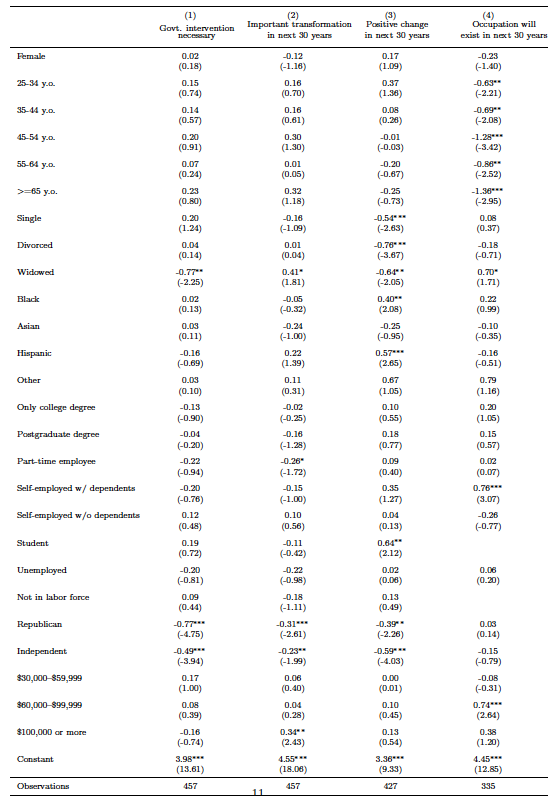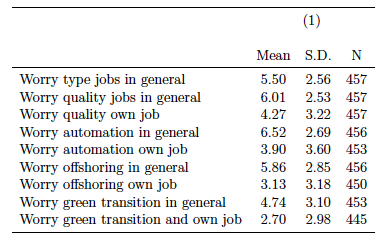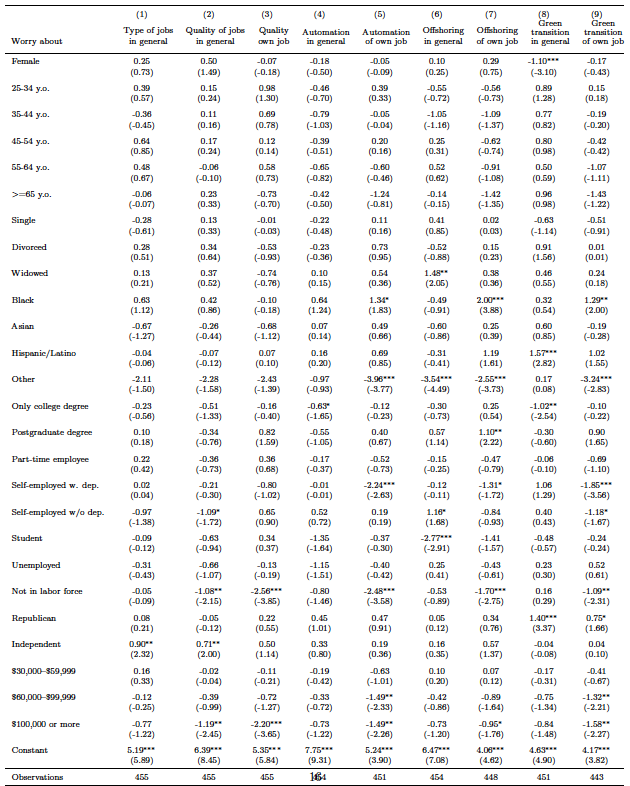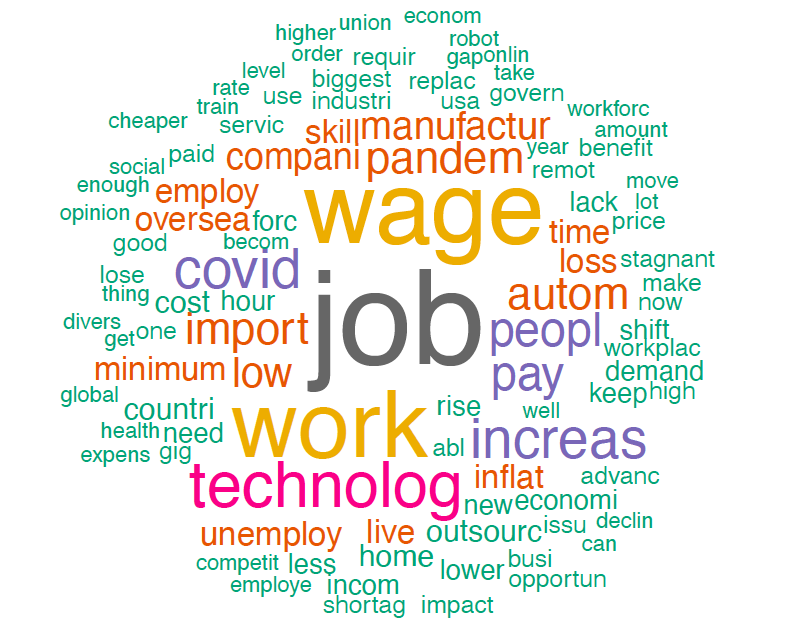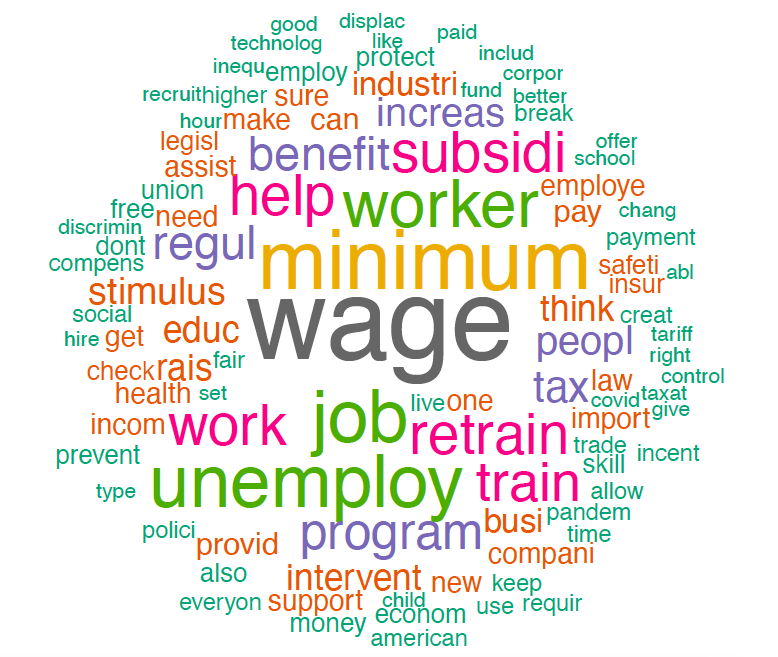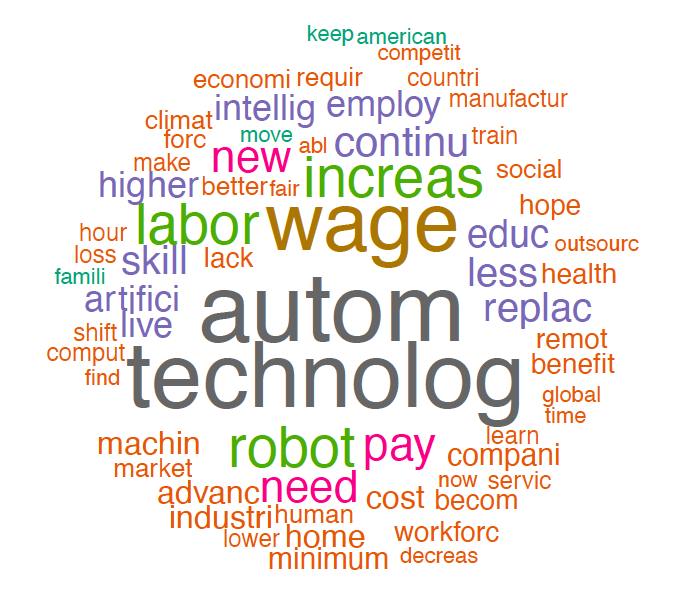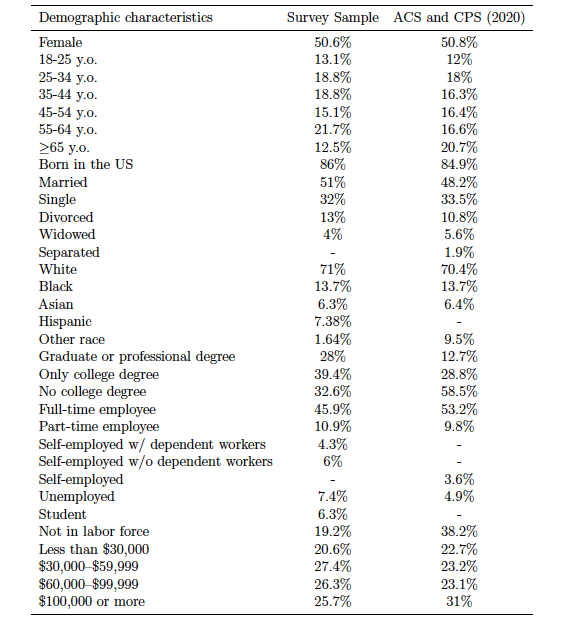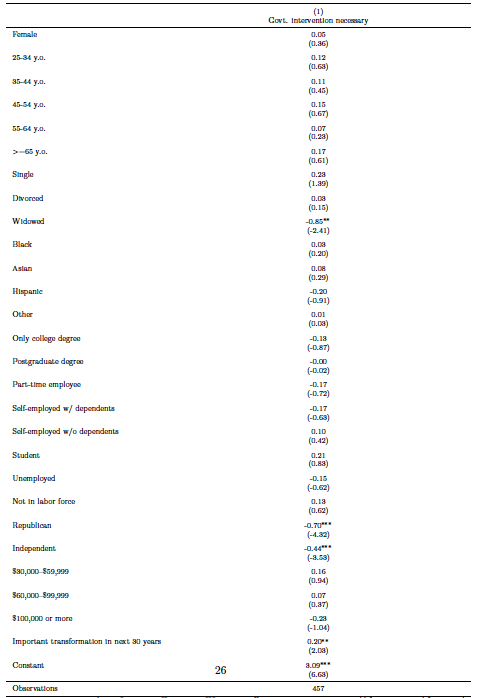1 Introduction
Perceptions play a vital role in shaping public policy as they influence the way people think and behave. Recent literature highlights that misperceptions are widespread and can lead to support for ineffective policies, which makes identifying the state of perceptions a significant public policy issue (see Bursztyn and Yang (2022) for a summary of the literature). In the context of labor economics, research has shown that workers’ perceptions of the labor market play a critical role in driving economic outcomes. For instance, the way workers perceive it can impact their decisions to apply for a job, demand higher salaries, or support anti-immigration or anti-trade policies.
To better understand workers’ perceptions of the labor market, researchers have used surveys and experiments. For example, a recent study by Di Tella and Rodrik (2020) examines how different labor market shocks affect people’s demand for government intervention. The researchers find that trade shocks generate more demand for protectionism than other shocks with the same impact on jobs, and outsourcing to a developing country leads to more demand for protectionism than outsourcing to a developed country. Similarly, Haaland and Roth (2020) show that people’s concerns about the labor market can affect their support for immigration. They conduct a survey experiment and find that presenting evidence showing no negative impact of immigration on the labor market increased support for immigration among respondents and this effect persisted over time.
In another recent study, J¨ager et al. (2022) find that workers’ beliefs about their options for alternative employment are often inaccurate, particularly among low-wage workers. The researchers find this by asking a representative sample of the German population about their views on alternative employment opportunities and comparing their responses with administrative data. They estimate that if workers had more accurate perceptions, at least 10 percent of jobs would not be viable at current wages. Hence, understanding how people perceive the labor market is crucial for designing successful policies.
This paper provides insights into how Americans view the labor market, using both an exploratory survey designed to avoid priming respondents to think about particular instances and open-ended questions to capture their unfiltered thoughts.1The survey questions are available at https://drive.google.com/file/d/1PZJNHLODexwoQiYm6VerrLGpRQoNLi-U/view?usp=sharing. The paper’s main contribution to the existing literature is its use of open-ended questions to collect opinions on past and future developments of the US labor market. Using open-ended questions enables us to uncover perceptions without biasing participants to think about specific events and allows respondents to express themselves freely without being limited by answer choices. In that way, it becomes possible to open a black box and accumulate more detailed information on viewpoints. The survey also includes close-ended questions that shed light on views regarding government intervention and anxiety related to future economic transformations.
The paper reveals several important findings. First, wage concerns are the most commonly cited topic among respondents when reflecting on the evolution of the US labor market over the past two decades. Second, when considering the future of work, respondents are most concerned about automation. Third, significant partisan differences exist in perceptions of the past and future evolution of work and preferences for government intervention. Finally, Black and Hispanic respondents are more worried about automation, globalization, and the green transition than White respondents.
The rest of the paper is structured as follows. Section 2 provides information on the survey’s structure and conduct. Section 3 presents the survey results, which are divided into three parts: perceptions of past developments (section 3.1), preferences for government intervention (section 3.2), and perceptions of the future of work (section 3.3). Section 4 concludes.
2 Survey Structure and Conduct
2.1 Survey Structure
The survey was exploratory and did not include any priming or provision of information. On the contrary, it was designed to avoid priming respondents on specific topics and mixed multiple-choice and open-ended questions.
Respondents started by answering a series of basic demographic questions. Afterwards, a first block of questions focused on the evolution of the US labor market over the past 20 years and support for government intervention on the labor market. A second block of questions then measured perceptions of future developments on the labor market, including whether these changes would be positive or negative, whether one’s occupation would still exist in the future, and the type of challenges American workers will face. The block finished by measuring the respondent’s level of worry regarding different economic disruptions such as automation, globalization, and the green transition.
The survey was careful not to mention any specific kind of economic transformation before it ended so as not to influence the respondent’s answers. Nevertheless, the questions emphasized that respondents should think of “important changes” or changes that “have transformed its (the labor market’s) functioning.” Hence, the aim was to measure perceptions of structural labor market events rather than cyclical short-term ones.
2.2 Survey Conduct
The survey was designed on Qualtrics and was distributed by Prolific, an online panel, to a representative sample of the US population in terms of age, gender, and ethnicity. It was conducted online over three days, between September 23, 2021 and September 25, 2021.
In total, 560 people clicked on the survey link. Among them, 10 timed out, 27 decided not to submit their answers, and 19 were rejected. Rejected responses included participants who finished the survey in less than one minute, failed the attention check, or were flagged by Qualtrics as potential bots. Out of the 504 approved answers, I dropped the submissions of those in the first percentile of the survey duration, that is, those who took less than 3 minutes to submit the survey, and dropped the submission of respondents whose internal score at Prolific was less than 95 percent.2Respondents’ scores reflect the quality of their answers based on their previous submissions. After these manipulations, 489 participants remained. Survey participants were remunerated 1.29 USD for their participation, and the median completion time was 7.9 minutes.
Table A.1 compares the average sociodemographic characteristics of the sample to the 2020 American Census Survey. The survey is broadly representative in terms of gender, age,3I have an overrepresentation of 55- to 64-year-olds and an underrepresentation of individuals older than 65, but the overall the sample is representative of those older than 55. Having a lower representa- tiveness of individuals older than 65 is a common issue for online surveys. birth in the US, ethnicity, and marital status. Survey participants are more educated and have higher household incomes than the average of the population. In addition, the sample has more unemployed people than the general population but has fewer full-time employees and people out of the labor force. It is also more Democrat than average: 52.3 percent of respondents identifies as Democrat, 18.4 percent as Republican, and 26.6 percent as Independent. This compares to 29 percent of Democrats, 29 percent of Republicans, and 41 percent of Independents in Gallup’s September 2021 survey.4See “Party Affiliation” estimates published by Gallup at https://news.gallup.com/poll/15370/party-affiliation.aspx. Last accessed on 04/26/2023.
To address external validity concerns, I construct poststratification weights to make the sample representative of the general population.5I create weights using the Stata package “ipfweight,” which generates weights through a stepwise iterative process, to reach the margins of the following population distribution: sex (two categories), age (six categories), race (four categories), income (four categories), education (three categories), and political affiliation (three categories). I only display weighted results (for both the regression and the topic analysis), but the results remain similar when conducting the analysis without weights. Using weights leads to a drop in my sample size to about 450 respondents.
Compared to probability-based samples, online panels representative in terms of observables are sometimes seen as less representative of the US population and hence less informative. Nevertheless, there remains self-selection into participation with probability-based samples, and using an online panel provider with quota sampling and poststratification remains a valid, and cheaper, alternative (see Haaland et al. (2023) for a discussion of this issue). Overall, the small sample size does not allow me to formulate policy recommendations but provides indicative evidence of what people think and see as important.
3 Results
3.1 Perceptions of Past Development on the US Labor Market
The first part of the survey asks respondents to identify the most significant change that American workers have faced over the last 20 years through an open-ended question. Figure A.5 displays the word cloud generated from their answers, indicating the most frequently cited words. The size of each word reflects the frequency of its mention. The word cloud shows that wage-related issues were most commonly mentioned, followed by technological advancements, the COVID-19 pandemic, import competition/offshoring, and skills/education.
To quantify the prevalence of these issues, I conduct a topic analysis and classify the words from the open-ended responses into different categories. I follow the methodology proposed by Ferrario and Stantcheva (2022) and define five categories:6As suggested by Ferrario and Stantcheva (2022), I define these categories by examining a document- term matrix and identifying the most common terms. This method is believed to produce better results than natural language processes, such as latent Dirichlet allocation (LDA), for survey questions that tend to be shorter and on which LDAs have not necessarily been trained.
- Wage: low wages and purchasing power issues
- Technology: technological advancement and automation
- Globalization: import competition and offshoring
- Covid: the recent Covid pandemic
The list of words associated with each category is available in section A.1. Each time one of these words is mentioned, a score of one is assigned to the corresponding category, giving me a crude measure of the topics most mentioned as important changes in the US labor market over the last 20 years. I then classify each respondent’s answer according to whether they mention one of the topics or not.7Hence, a respondent’s answer can fall into several categories. The measure is on the extensive margin—whether one mentions the topic or not—rather than on the intensive one—how many times and to which length the respondent mentions the topic.
Figure 1 shows that the issue of low wages is the most cited category: 25 percent of documents mention it. It is followed by the Covid pandemic (22 percent), technology (21 percent), and globalization (16 percent). Manufacturing and skills are cited less often (5 and 4 percent, respectively). Overall, the responses to this answer reflect that Americans see the (lack of) evolution of wages in the US over the last 20 years as the most pressing concern.
Figure 1. Text Classification of the Answers to the Question “What Is the Most Important Change American Workers Have Had to Face in the Last 20 Years?”
As partisanship influences one’s public policy views (Alesina et al., 2020), I explore whether this is the case in my survey and break down the results by political affiliation. Figure 2 shows that Democrats and Independents are much more likely to mention low wages than robots, globalization, Covid, manufacturing, or skills. On the contrary, Republicans cite Covid concerns much more than the other topics, highlighting that perceptions of past development on the labor market differ by political affiliation.
Figure 2. Text Classification by Political Affiliation of the Answers to the Question “What Is the Most Important Change American Workers Have Had to Face in the Last 20 Years?”
3.2 Preferences Regarding Government Intervention on the Labor Market
I then ask respondents whether they believe that government intervention is necessary following a labor market shock that “changes its functioning and structure over the long term.” The large majority of respondents answer yes, with 28 percent choosing “definitely yes” and 40.7 percent “probably yes” (figure A.1).
I next run a simple linear regression to see which covariates are associated with more support for government intervention.8The results remain unchanged with a logit regression. Table 1 shows that political affiliation leads to a significant difference in the way people answered. In particular, Republicans and Independents are less likely than Democrats to believe that government interventions are necessary when the labor market faces a structural change. Interestingly, Independents exhibit an intermediary position, being also more likely to favor government intervention than Republicans (the difference between the two is significant).9Widowed people are also less likely to support government interventions compared to married people, with no clear interpretation as to why.
Respondents subsequently provide examples of successful government interventions in an open-ended text box. Increasing the minimum wage, unemployment benefits, and retraining programs are the most cited, as shown in figure A.6’s word clouds.
Using the same methodology as in section 3.1, I then conduct a topic analysis where I classify the answers according to the following topics:10See section A.2 for a definition of the word dictionary used.
- Transfers: social transfers and benefits
- Retraining: the need for training and education
- Regulation: the inadequacy of government oversight
- Protect: the inadequacy of government protection
- Minimum wage: the need to increase incomes, the minimum wage, or both
- Tariff: limits on trade and offshoring
- Discrimination: discrimination based on race, gender, or both
Figure 3 shows that the topics rank as (i) transfers, (ii) regulation, (iii) retraining, (iv) an increase in wage, (v) protection, and (vi) the implementation of tariffs. Interestingly, while “wage” and “minimum wage” are the most cited overall (see the word cloud in figure A.6), a bigger share of respondents mention transfers (see figure 3). Indeed, the same answer from one respondent can include the word “wage” several times, increasing its overall frequency and therefore its importance in the word cloud.
Figure 3. Text Classification of the Answers to the Question “What Are Successful Types of Government Interventions on the Labor Market According to You?”
Decomposing by political affiliation, figure 4 shows that Republicans cite regulation topics more often, while Democrats tend to mention transfers first. Independents are most likely to have answers that relate to transfers or retraining, and a bigger share of them mention tariffs compared to Democrats and Republicans.
Figure 4. Text Classification by Political Affiliation of the Answers to the Question “What Are Successful Types of Government Interventions on the Labor Market According to You?”
3.3 Perceptions on the Future Evolution of Work
The survey then focuses on people’s expectations about the future of work, using three questions:
- Do you think the US labor market will experience significant transformations over the next 30 years?
- Do you think the next three decades will bring positive or negative changes to the US labor market?
- Do you think the type of occupation you have/had will still exist 30 years from now?
The results show that a majority of respondents expect significant transformations to occur in the US labor market over the next 30 years (see figure A.2). Most respondents hold optimistic views about the future of work, with 54.9 percent believing that the changes will be positive and 75.5 percent thinking their occupation will still exist in the next 30 years (figure A.3).
Table 1 presents how demographic factors affect the survey responses. Political affiliation appears to be a significant predictor of attitudes toward the future of work, with Republicans and Independents being less likely to anticipate substantial transformations and positive changes in the next 30 years (columns 2 and 3). However, no partisan differences emerge regarding the likelihood of one’s occupation existing in 30 years.
Other demographic factors include unmarried respondents who are less optimistic about the future of work, while widowed respondents express confidence in both the occurrence of significant transformations and the longevity of their occupation. Black and Hispanic respondents are more likely to believe that the US labor market will experience positive changes in the next three decades than White respondents, but no significant differences emerge regarding the other two survey questions. Education level does not affect the responses, but part-time employees, self-employed individuals with dependents, and students exhibit distinct patterns. Finally, those in the highest income bracket are more likely to believe important changes will occur in the future, and those in the $60,000–$100,000 income bracket are more likely to think their job will still exist in 30 years.
Table 1. Covariates of Labor Market and Government Perceptions
t-statistics are in parentheses. * p < 0.10, ** p < 0.05, ***p < 0.01. Base categories: 18–25 years old for age, married for marital status, White for race, high school degree or less for education, full-time employee for employment status, Democrat for political affiliation, and less than $30,000 for household income.
To further explore the partisan differences, I rerun the same regressions as column 1 of table 1 but include the variable “Important transformation in the next 30 years” as a control. By doing that, I can test for the hypothesis that Republicans and Independents are less supportive of government intervention because they do not believe that important transformation will occur in the next 30 years. Table A.2 shows that the additional variable is a significant predictor of the support for government intervention but does not cancel the partisan differences picked up in table 1. This finding suggests that the partisan differences I uncover are not driven by Republicans’ belief that the labor market will not transform.
I then ask respondents for their opinion about the changes American workers will face over the next 30 years. I create word clouds to identify the most frequently cited changes (see figure A.7). The word clouds show similarities to those of figure A.5, which focus on changes over the last 20 years. However, the prevalence of technological change and automation is more prominent now. Using the same topic classification methodology as in section 3.1, I analyze how topics compare to each other and to the question on the past evolution of the US labor market. I also add a new category on the environment, which covers mentions of climate change and the transition to a green economy.
Figure 5 shows that concerns over robots and automation become dominant. They are followed by worries about low wages, the most cited category when it comes to developments over the last 20 years. While globalization and COVID-19 were prominent when it came to past changes, they are now less important, and skills and environmental concerns gain traction.
Figure 5. Text Classification of the Answers to the Questions “What Is the Most Important Change American Workers Have Had to Face in the Last 20 Years?” and “What Are Important Changes American Workers Will Have to Face over the Next Three Decades?”
When decomposing the results by political affiliation (figure 6), there is relative consensus across the political spectrum. Democrats, Republicans, and Independents all cite robots and automation more frequently than other topics. This consensus contrasts with the political differences observed when it comes to perceptions of the past evolution of the labor market (figure 2). The distribution along the political dimension for each topic is broadly similar except for wage-related topics. Democrats and Independents are more likely to cite these issues compared to Republicans.
Figure 6. Text Classification by Political Affiliation of the Answers to the Question “What Are Important Changes American Workers Will Have to Face over the Next Three Decades?”
Finally, I ask respondents to rate from 0 to 10 their level of worry regarding the future of job quality, automation/robotization, offshoring, and the transition to a green economy. In each case, I ask them how worried they are in general and how worried they are with regards to their own job. Table 2 provides summary statistics, and it shows that survey respondents are more worried about automation than job offshoring and the transition to a green economy when it comes to jobs in the future. Interestingly, Americans are more likely to worry about these issues and how they relate to the labor market in general than their own jobs specifically. This finding is in line with a previous survey conducted by Pew, which shows that while many Americans expect numerous professions to be dominated by machines within their lifetime, few expect their own jobs to be impacted (Anderson and Smith, 2017). This could suggest that Americans tend to believe their jobs will remain insulated from these labor market trends.
Table 2. Summary Statistics: Average Level of Worry (from 0 to 10)
To estimate the factors that influence one’s level of worry, I conduct regression analysis on each worry variable using the same set of sociodemographic characteristics. Table 3 displays the output, and a few things stand out. First, Black respondents are more likely to be worried about the impact of each labor market change on their own job, while Hispanic respondents are more likely to be worried about the effect of the green transition in general, but this effect loses significance when asked about the impact on their own job.
Table 3. Covariates of worry levels
t-statistics are in parentheses. * p < 0.10, ** p < 0.05, *** p < 0.01. Base categories: 18–25 years old for age, married for marital status, White for race, high school degree or less for education, full-time employee for employment status, Democrat for political affiliation, and less than $30,000 for household income.
Second, there is no clear association between education level and worries except for general labor market upheavals (i.e., not specific to one’s own occupation). For example, those with only a college degree are less likely to be worried about automation or the green transition than those without one. Third, two interesting findings emerge on worries related to the green transition: women are less likely to be worried than men, and there are significant partisan divisions, with Republicans being more worried than Democrats. Finally, higher income levels correlate with lower levels of worry. This is particularly the case for questions that ask respondents to think about the impact on their own job.
4 Conclusion
These results illustrate that Americans perceive the past and future evolution of the labor market differently. Salary concerns are the most salient issue when it comes to past developments, whereas technology emerges as the primary issue concerning the future of work. Partisan differences are more apparent in the evaluation of past developments and in preferences regarding government intervention compared to views on future labor market developments. In addition, respondents express higher levels of anxiety about the impact of labor market changes in general rather than on their own occupation when asked about their worries on future work transformations. There are also apparent ethnic differences, with Black and Hispanic respondents expressing more concerns about automation, globalization, and the green transition compared to White respondents.
The noticeable concerns regarding the impact of new technologies on work in the future contrasts with recent findings that show that Americans do not react particularly strongly to automation-induced labor displacement (Di Tella and Rodrik, 2020; Jeffrey and Matakos, 2021; Ladreit, 2022). This implies that the limited “backlash” against robots witnessed so far does not stem from a lack of anticipation or saliency but likely reveals more tolerant views on the fairness of labor displacement by robots.11See, for example, Ladreit (2022) for a discussion. In addition, people appear to worry less about the green transition than globalization and automation, yet recent analysis highlights the important local labor market repercussions of the green transition for workers employed in the fossil fuel industry (Hanson, 2023). Indeed, fossil fuel extraction and refining, which are only one link of the industry, employed 729,000 workers in 2021.12See Hanson (2023) for more details on the estimate by local labor markets. More work on this topic, and the extent to which people anticipate it and are willing to retrain toward other types of jobs, is needed.
Overall, mixing multiple-choice and open-ended questions in surveys can be an effective tool for investigating people’s perceptions. Open-ended questions can be a valuable complement to better understand the salience of specific topics and the mechanisms of how people think. With new text analysis tools, answers to open-ended questions can be classified in a more systematic way, and surveys could incorporate open-ended questions to measure which issues are more prominent in people’s minds and how they process information and reason. Doing so would enable policymakers to better measure citizens’ policy preferences and views on the economy and therefore design more adequate public policies.
A Topic Analysis Dictionaries
A.1 Dictionaries Used for the Following Questions: “What Is the Most Important Change American Workers Have Had to Face in the Last 20 Years?” and “What Are Important Changes American Workers Will Have to Face over the Next Three Decades?”
- Wage: “pay,” “inflat,” “increas cost,” “cost live,” “price,” “earn,” “wage,” “afford,” “increas minimum,” “increas liveabl,” “exploit,” “salary,” “income,” “money work,” “compensation”
- Technology: “autom,” “robot,” “ai,” “artifici intellig,” “technolog,” “comput,” “machine,” “tech,” “automat,” “internet,” “gig,” “obsolesc,” “obsolete,” “digit”
- Covid: “covid,” “corona,” “coronavirus,” “pandem,” “remot,” “health,” “sick,” “vaccin,” “work home,” “stay home,” “lockdown,” “virus,” “mask”
- Globalization: “offshor,” “outsourc,” “oversea,” “import,” “abroad,” “china,” “mexico,” “chines,” “world,” “globalizat,” “global,” “trad,” “ship,” “foreign,” “export,” “compani leav,” “compani mov,” “intern competit”
- Manufacturing: “manufactur,” “mfg,” “change industry,” “blue collar,” “manual”
- Skills: “skill,” “unskill,” “analyt,” “educ,” “train,” “retrain,” “job requir,” “prepar job,” “qualif,” “diploma,” “degre”
- Environment: “green,” “climat,” “warm,” “planet,” “fossil,” “fuel,” “carbon,” “renewabl,” “temperature”
- Don’t know: “dont know,” “dont see any,” “cant see any,” “cant think any,” “dont really know,” “couldnt tell,” “not sure,” “unsure”
A.2 Dictionaries Used for the Question “What Are Important Changes American Workers Will Have to Face over the Next Three Decades?”
- Transfers: “check,” “subsidi,” “stimulus check,” “benefit,” “money,” “compens,” “social,” “payment,” “cash”
- Regulation:13I check the content of these responses, and the vast majority of respondents express support for more regulation. Nevertheless, some mention there are too many regulations and taxes in the US. I do not make any distinction between the two here and aim to reflect the idea that respondents believe the current US regulatory environment is not adequate.“regul,” “allow,” “taxat,” “tax,” “control,” “legisl,” “law,” “incent,” “oversight”
- Protect: “protect,” “union,” “help,” “assist,” “welfare,” “support,” “healthcar,” “insur”
- Retrain: “retrain,” “train,” “recruit skill,” “educ,” “training,” “school”
- Minimum wage: “minimum,” “higher wage,” “wage subsidi,” “increa wage,” “pay more,” “increa income,” “more pay,” “more income”
- Tariff: “import,” “tariff,” “trade,” “oversea,” “border,” “reloc home,” “reloc america,” “offshor,” “reloc usa,” “reloc us,” “move back”
- Discrimination: “gender,” “dei,” “sexism,” “promote divers,” “discrimin,” “race,” “antidiscrimin,” “racism”
- Don’t know: “dont know,” “dont see any,” “cant see any,” “cant think any,” “dont really know,” “couldnt tell,” “not sure,” “unsure”
B Figures
Figure A.1. Support for government intervention
Figure A.2. Views on future labor market transformations
Figure A.3. Views on whether future labor market transformations will be positive or negative
Figure A.4. Views on whether one’s occupation will still exist 30 years from now
Figure A.5. Word Cloud of Answers to the Question “What Is the Most Important Change American Workers Have Had to Face in the Last 20 Years?”
Figure A.6. Word Clouds of Answers to the Question “What Are Successful Types of Government Interventions on the Labor Market According to You?”
Figure A.7. Word Cloud of Answers to the Question “What Are Important Changes American Workers Will Have to Face over the Next Three Decades?”
C Tables
Table A.1. Sociodemographic Characteristics of the Survey Sample Compared to the American Census Survey
Employment data are from the 2020 American Census Survey and as a percentage of the civilian noninstitutional population over the age of 16 years.
Table A.2. Covariates of Labor Market and Government Perceptions: Including Perceptions of Future Work Transformation
t-statistics are in parentheses. * p < 0.10, ** p < 0.05, *** p < 0.01. Base categories: 18–25 years old for age, married for marital status, White for race, high school degree or less for education, full-time employee for employment status, Democrat for political affiliation, and less than $30,000 for household income.
References
Alesina, Alberto, Armando Miano, and Stefanie Stantcheva (2020). “The polarization of reality.” AEA Papers and Proceedings 110, 324–328.
Anderson, Monica and Aaron Smith (2017). Automation in everyday life. Pew Research Center.
Bursztyn, Leonardo and David Y Yang (2022). “Misperceptions about others.” Annual Review of Economics 14, 425–452.
Di Tella, Rafael and Dani Rodrik (2020). “Labour market shocks and the demand for trade protection: Evidence from online surveys.” The Economic Journal 130 (628), 1008–1030.
Ferrario, Beatrice and Stefanie Stantcheva (2022). “Eliciting people’s first-order concerns: Text analysis of open-ended survey questions.” AEA Papers and Proceedings 112, 163– 169.
Haaland, Ingar and Christopher Roth (2020). “Labor market concerns and support for immigration.” Journal of Public Economics 191, 104256.
Haaland, Ingar, Christopher Roth, and Johannes Wohlfart (2023). “Designing information provision experiments.” Journal of Economic Literature 61.1, 3–40.
Hanson, Gordon H (2023). Local Labor Market Impacts of the Energy Transition: Prospects and Policies. Working Paper 30871. National Bureau of Economic Research.
Ja¨ger, Simon, Christopher Roth, Nina Roussille, and Benjamin Schoefer (2022). Worker beliefs about outside options. Working Paper 29623. National Bureau of Economic Research.
Jeffrey, Karen and Konstantinos Matakos (2021). Learning about future shocks while still caught up in past ones: How perceptions of fairness and economic vulnerability influence redistributive preferences and behavior. QPE Working Paper 29. Quantitative Political Economy research group.
Ladreit, Colombe (2022). Automation and public policy preferences. Baffi Carefin Centre Research Paper 191. Baffi Carefin Centre.


